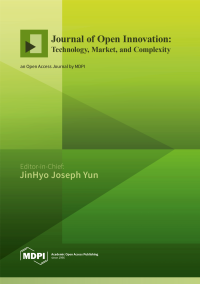Business, Open Innovation and Art
A special issue of Journal of Open Innovation: Technology, Market, and Complexity (ISSN 2199-8531).
Deadline for manuscript submissions: closed (30 November 2018) | Viewed by 55213
Special Issue Editors
2. Editor, Essinova Journal
3. Facilitator and Coach, Executive Education, Stanford Graduate School of Business, Stanford University, Stanford, CA 94305, USA
Interests: creativity; innovation; business; art; management; leadership; science; technology; design; nature
2. Founder, International Entrepreneurship Academy Network
3. Adjunct Professor of Knowledge Economics, Innovation and Entrepreneurship, Faculty of Entrepreneurship, University of Tehran, Tehran, Iran4. Guest Professor, University of Tartu, Tartu, Estonia
Interests: economics; innovation; entrepreneurship
2. Founder, CoCreation Leadership Development
3. Founder, Sensing Mind Institute
Interests: leadership education; art; cognitive science; systems of personal development; co-creation; entrepreneurship
Special Issue Information
Dear Colleagues,
In spite of modern perceptions of art and business as being polar opposites of the other, both in terms of value systems and of operating fundamentals, business has much to learn from the arts, and management is more of an art than people recognize. Successful artists and executives share common prerequisites. Business can grow artistically by the alchemy of invention. As companies find their business environment increasingly complex to navigate, like perpetual whitewater brought upon by unprecedented technological and social changes, art can be a powerful tool to catalyze innovation and transform culture, helping companies discover/re-discover their compass, create new rafts to conquer the rapids and find “blue ocean” market spaces far ahead of competition.
From industry leaders such as Autodesk and Google to frontier startups such as Planet.com, forward-thinking companies have adopted artist-in-residence programs to maintain creative edge and catalyze new business opportunities. European Commission has launched the START prize, featuring innovative cooperation between art and industry/technology. There have also been some studies demonstrating the linkage between creativity training and the bottom-line. However, such studies are few and far between, and the vast majority of businesspeople cannot see much use for art in business beyond decoration in the lobby and maybe some branding value.
We invite potential contributors to submit essays, case studies and research findings articulating and proving arts’ value for business management, especially for innovation. We particularly welcome insights and data addressing the frequently asked question from the skeptics: “What is the ROI of an art program?” We also encourage any views on the difference between art and design, and any art-thinking framework, which might take the popular design-thinking approach a step further. Insights from creative industries that have broader applicability to the business world would be appropriate as well.
Ms. Beibei Song
Prof. Piero Formica
Dr. Claus Springborg
Guest Editors
Manuscript Submission Information
Manuscripts should be submitted online at www.mdpi.com by registering and logging in to this website. Once you are registered, click here to go to the submission form. Manuscripts can be submitted until the deadline. All submissions that pass pre-check are peer-reviewed. Accepted papers will be published continuously in the journal (as soon as accepted) and will be listed together on the special issue website. Research articles, review articles as well as short communications are invited. For planned papers, a title and short abstract (about 100 words) can be sent to the Editorial Office for announcement on this website.
Submitted manuscripts should not have been published previously, nor be under consideration for publication elsewhere (except conference proceedings papers). All manuscripts are thoroughly refereed through a single-blind peer-review process. A guide for authors and other relevant information for submission of manuscripts is available on the Instructions for Authors page. Journal of Open Innovation: Technology, Market, and Complexity is an international peer-reviewed open access quarterly journal published by MDPI.
Please visit the Instructions for Authors page before submitting a manuscript. The Article Processing Charge (APC) for publication in this open access journal is 800 CHF (Swiss Francs). Submitted papers should be well formatted and use good English. Authors may use MDPI's English editing service prior to publication or during author revisions.
Keywords
- Creative leadership
- Artful management
- Artful innovation
- Art
- Creativity
- Innovation
- Creativity training
- Art-thinking
- Design-thinking
- Leadership
- Management
- Business
Benefits of Publishing in a Special Issue
- Ease of navigation: Grouping papers by topic helps scholars navigate broad scope journals more efficiently.
- Greater discoverability: Special Issues support the reach and impact of scientific research. Articles in Special Issues are more discoverable and cited more frequently.
- Expansion of research network: Special Issues facilitate connections among authors, fostering scientific collaborations.
- External promotion: Articles in Special Issues are often promoted through the journal's social media, increasing their visibility.
- e-Book format: Special Issues with more than 10 articles can be published as dedicated e-books, ensuring wide and rapid dissemination.
Further information on MDPI's Special Issue polices can be found here.







